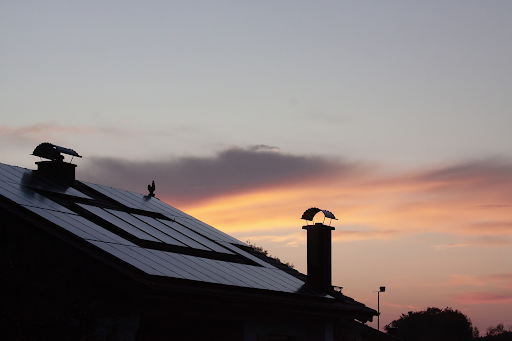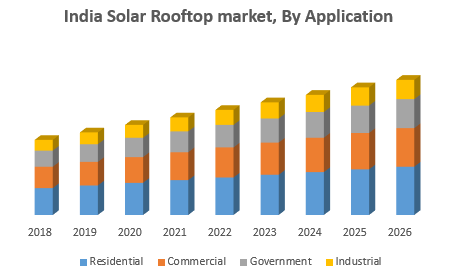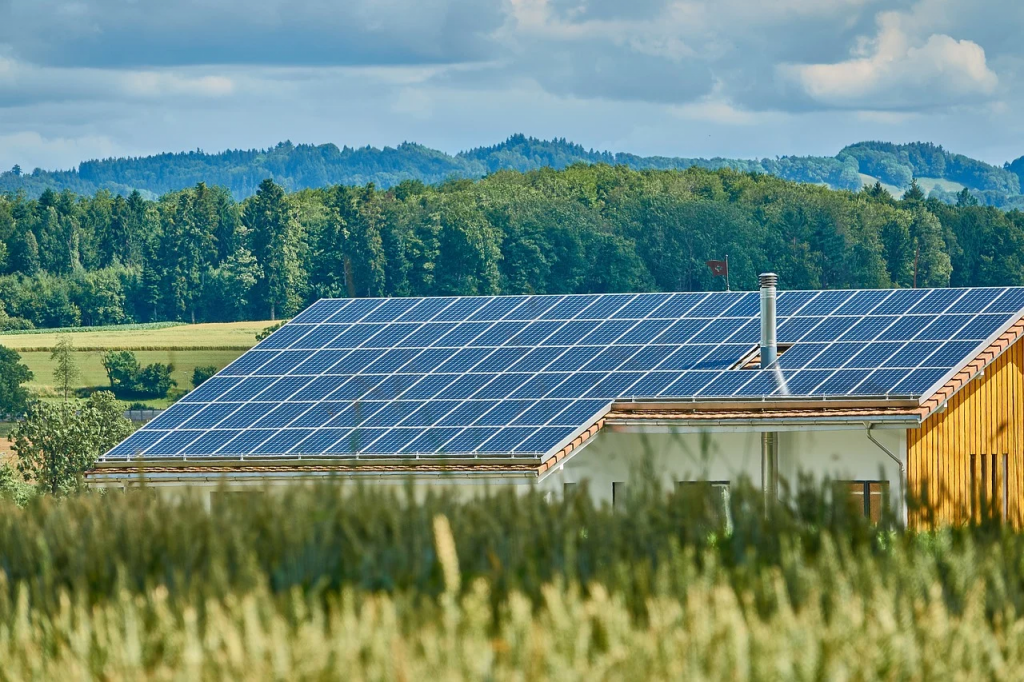Table of Contents
ToggleExcess use of natural resources such as coal and petroleum has nearly driven its resources into sheer exhaustion. It is high time to adopt the use of renewable resources for more efficient and better use of energy.
When it comes to harnessing solar power through the use of rooftop solar panels, the country of India holds significant advantages, mainly due to its geographical positioning and favourable weather, which ensures abundant sunshine throughout the year.
In India, the major bottlenecks in the rapid adoption of solar rooftops are the lack of relevant information and the absence of easy financing options.
The graph below shows the solar energy capacity in India from 2009 to 2019.


In recent years, it has been noted that the cost of rooftop solar panels and solar rooftops in India has come down drastically, mainly due to improved technology and other factors such as subsidies and so on.
It is entirely possible to recover the cost of solar panels in 5-6 years.
What is rooftop solar?
These are solar panels which are placed on the roof of residential, commercial or institutional buildings.
When the light and heat energy from the sun falls on the solar cells, it is converted into electrical energy. This arrangement is known as a solar photovoltaic system or rooftop solar voltaic system.
The only requirement for this system to work efficiently is abundant sunlight and enough space for installation. The great thing about this system is that it produces clean and eco-friendly energy.
Is community solar a better option than rooftop solar?


Community solar refers to a stand-alone system which is designed to generate electricity to power dozens to hundreds of homes.
Community solar is an excellent alternative to rooftop solar.
Quite commonly known as solar farms, these power generating systems are owned by third-party developers under a power purchase agreement.
There are various modes of financing these projects, but the most common way is to sell subscriptions to customers of the utility.
Both rooftop solar and community solar are capable of providing 100% renewable power to reduce the dependence on fossil fuels and to lower electricity bills. The main difference is in the ownership and location of the installation.
Installing rooftop solar Photovoltaic Panels
The rooftop photovoltaic system is nothing but a series of solar panels mounted on the roof of commercial or residential buildings for harnessing solar power.


Up till now, we have not developed a technology to meet 100% of the electricity demands of a regular building.
However, research is still progressing to make more efficient and better functional solar panels. By using roof-mounted solar panels, you can drastically reduce the dependence on power obtained through the electric grid.
For domestic owners, this means lower electricity bills.
Whether a rooftop photovoltaic system is beneficial for you or not is dependent on several factors such as:
- Geographical conditions
- Weather conditions
- Altitude
- Shade from surrounding trees or building
- Amount of inclination of the roof etc.
India’s rooftop solar capacity
When it comes to rooftop solar capacity, India has immense potential.
Official reports have suggested that the cumulative solar capacity of India has reached over 4.4 GW by the end of the year 2019.
The increased adaptation of solar power in India can be given credits to increased consumer awareness, customer friendly net metering policies, corporate social responsibility and increased consumer awareness.
The graph below shows the total installed rooftop capacity in India.


The IEEFA estimates that within the next three years, rooftop solar in India will grow at a CAGR of 50%, which suggests a cumulative 13 GW of installed capacity by FY 2021-22.
Rooftop solar has a compound annual growth of 116% between 2012 and 2018.
70% of its market growth can be given credit to commercial and industrial (C&I) consumers with the aid of incentives
Why does India have great solar potential?
The solar potential of a specific region is assessed based on certain factors such as the amount of solar radiation received, availability of land etc.
Geographically the country of India gets abundant sunlight throughout the year, which is a fantastic opportunity for harvesting solar energy.
The National Institute of Solar Energy (NISE), an apex institute of the Ministry of New & Renewable Energy (MNRE), has estimated that the country has a potential solar energy of 750 GWp.
Additionally, the solar power sector in India has a massive potential to create new jobs. 1 GW of Solar manufacturing units will create approximately 4000 direct and indirect jobs.
Rooftop solar market in India
The rooftop solar market is growing at a rapid pace in India, thanks to the advantageous position in the solar belt that this country enjoys. Favourable government policies and growing awareness about renewable energy among the millions are an added advantage.
Thanks to the Ministry of New and Renewable Energy, there are currently around 1000 rooftop installers in India.
Solar market in India is expected to grow at a CAGR of more than 25% throughout 2020-2025
The government has formulated several policies to boost solar energy production in the country. By 2022 the National Solar Mission plans to scale up the renewable power generation to 100 GW.
The government in the Union Budget (2018-2019) has announced zero import duty for the parts used in manufacturing solar panels.
The Rooftop solar market is valued 2.52 Mn and is estimated to reach XX Mn by 2026.


The key players in the market include Electrician Services, 3dot Energy, 3en Clean Tech Pvt. Ltd., A&T Power Systems Pvt 7Parallels Techno-Consultants Pvt. Ltd., A.S.Infra Tech Ltd, A1 Power Solutions, Aarinas Power & Renewable Energy, Aaron Power Solutions, AA Solar India, Aarushee Solar Energy LLP, AB Energía Solutions Pvt. Ltd., Aatap Energy, Aavishkar Solar Technologies LLP, Aay Pee Wind Solar Systems, AB-HI Solar Pvt. Ltd.
Government subsidies for rooftop solar systems in India
Both the state and central government offer various subsidy schemes for installing the rooftop solar systems.
If you are located in a state belonging to the general category, you can avail a subsidy of 30%.
On the other hand, if you belong to select category areas such as Uttarakhand, Lakshadweep, Sikkim, Himachal Pradesh, and Jammu & Kashmir a subsidy of up to 70% is given by the central government.
Generation based incentives are also given to users who generate power of 1100 kWh – 1500 kWh per year.
To avail the subsidy, you need to contact your electricity provider who will visit the installation site for a review and give approval.
Rooftop solar companies in India
Following are the key rooftop collar panel manufacturing and installation companies in the country:
1. Tata Power Solar
This company ranks top among the most trusted and dependable rooftop solutions in India. Tata Power Solar has over 10,000 residential customers and has installed over 250 MW rooftop systems.
Some of their large scale installations include Cochin International airport, RSSB-EES Amritsar, cricket club of India etc.
2. Mahindra Susten
The company has given solar power solutions to various corporate companies such as Infosys, Tech Mahindra, JK Tyres, JK Fenner etc.
To date, Mahindra Susten has commissioned over 1210 MW, and over 1900 MW are under installation.
3. Loom solar
This is one of the leading solar rooftop installation companies in India with a huge capacity. They build solar plants which have powered more than 1000 homes across 700 cities in India.
They have a capacity ranging from 3 kW to 50 kW and 50 kW to 100 kW. They also have grid projects in commercial and residential spaces.
4. Fourth Partner Energy
The company has an excellent reputation for managing more than a hundred clients, such as Airtel, EY, Nestle, and others.
Fourth Partner Energy is one of the leading solar companies in India. With its distributed solar model, it has demonstrated that harnessing solar power can reduce emissions and avert more than 16 million tons of carbon.
5. Sunsure energy
The company specializes in large rooftop installations. Sunrise aims to create 1000MW of solar power assets by 2020 and installed over 20MW of rooftop solar power plants in 2018.
According to the “India Rooftop Solar Report 2018,” Sunrise Energy is the third-largest solar EPC company in India.
The future with rooftop Solars
In the last eight years, the Indian solar market has seen significant growth from 40 MV to 26,000 MV.


In May 2016, the world’s largest single rooftop solar power plant having 11.5 MW capacity was inaugurated in Beas, Punjab, India.
The overall capacity of installed rooftop solar power plants in India is 1443.7MW. Thus the rooftop solar panels can undoubtedly play a pivotal role in providing security of energy for the country.
The steady rise in solar power generation forms a vital part in reducing CO2 emission and turning towards a renewable and cleaner form of energy.
In addition to fulfilling the Paris Agreement (Produce 30% of energy from a clean power source), this will also help to reduce the air pollution and improve the health and well being at a drastic level.
Some of the significant findings regarding the efficacy of solar power in India are:
- The huge workforce requirement for the solar industry will help to employ 18 million people by 2050.
- Cost of manufacturing and installing solar cells is expected to decline in the coming years
- There is a rapid expansion of rooftop solar in India, mainly due to friendly policies such as net metering.
- Accelerated deployment of rooftop solar can decrease the carbon emission by up to 21%.
- By mid-century solar power could cover up one-quarter of the electricity needs.
- By 2020, it is estimated that the global capacity will become 18 times the present levels.






This Post Has 2 Comments
Great read! The blog provided valuable insights and clear explanations on the topic. I appreciate the well-researched content and practical takeaways. Looking forward to implementing some of these ideas into my daily routine!
The use of solar rooftops is a sustainable way to generate electricity. By harnessing the power of the sun, these rooftop installations can help reduce your carbon footprint and lower your energy bills. Solar rooftops are becoming increasingly popular due to their environmental benefits and long-term cost savings.